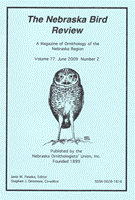Nebraska Ornithologists' Union

Nebraska Bird Review
Date of this Version
6-1987
Document Type
Article
Citation
Brogie & Brogie, "A Red-Naped Sapsucker in Sioux County, Nebraska," from Nebraska Bird Review (June 1987) 55(2).
Abstract
The Red-naped Sapsucker (Sphyrapicus nuchalis) has recently been recognized as a valid species (American Ornithologists' Union, 1985). Its inclusion in the avifauna of Nebraska is based on three birds, all taken in September in the northwestern corner of the state during the years 1919 and 1920 (Bray et al. 1986). Bray et al. (1985) give detailed accounts of these specimens and present an over-view of the species in Nebraska. The following, along with being the first spring record of the species in Nebraska, represents the first verified occurrence of this species in the state since 1920.
On the afternoon of 17 April 1987 we found an adult male-plumaged Red-naped Sapsucker inhabiting the ponderosa pine (Pinus ponderosa) forest along the upper reaches of Sowbelly Canyon, Sioux Co. The bird was first seen in flight, and exhibited a red crown, white wing patches, and a black and white back. When the bird came to rest at a distance of about 15 yards we could easily see the white and black face pattern, red throat with black below, and narrow longitudinal white wing stripe. The bird had a notable white V extending up the back, originating from a conspicuous white rump patch. The sides of the bird were somewhat barred, while the breast appeared unstreaked and had a faint yellowish wash. When the bird turned its head it displayed a red nape, which is the primary characteristic that separates this species from the congeneric Yellow-bellied Sapsucker (Sphyrapicus varius) with which it had previously been lumped.
The bird was easily approached as it foraged among the pines. It seemed to favor one particular group of trees, and upon closer inspection a "sap well" was found in an approximate eight-inch (diameter at breast height) 40-foot tall ponderosa pine. The "sap well" was located at a height of about nine feet above ground level, and consisted of two parallel rows of small holes that had been freshly drilled. We watched the bird for approximately 45 minutes, and on three occasions saw it fly to the "sap tree" above the "sap well" and then back itself down to the feeding area.
Identifiable photographs are in the possession of the authors and others have been sent to the Nebraska Records Committee. Unfortunately, none of the photographs seemed likely to produce a usable black-and-white reproduction for the Review.


Comments
Copyright 1987, Nebraska Ornithologists' Union. Used by permission.